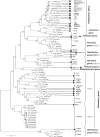Positive selection, molecular recombination structure and phylogenetic reconstruction of members of the family Tombusviridae: Implication in virus taxonomy
- PMID: 22215970
- PMCID: PMC3229121
- DOI: 10.1590/S1415-47572011005000046
Positive selection, molecular recombination structure and phylogenetic reconstruction of members of the family Tombusviridae: Implication in virus taxonomy
Abstract
A detailed study of putative recombination events and their evolution frequency in the whole genome of the currently known members of the family Tombusviridae, comprising 79 accessions retrieved from the international databases, was carried out by using the RECCO and RDP version 3.31β algorithms. The first program allowed the detection of potential recombination sites in seven out of eight virus genera (Aureusvirus, Avenavirus, Carmovirus, Dianthovirus, Necrovirus, Panicovirus, and Tombusvirus), the second program provided the same results except for genus Dianthovirus. On the other hand, both methods failed to detect recombination breakpoints in the genome of members of genus Machlomovirus. Furthermore, based on Fisher's Exact Test of Neutrality, positive selection exerted on protein-coding genes was detected in 17 accession pairs involving 15 different lineages. Except genera Machlomovirus, and Panicovirus along with unclassified Tombusviridae, all the other taxonomical genera and the unassigned Tombusviridae encompassed representatives under positive selection. The evolutionary history of all members of the Tombusviridae family showed that they segregated into eight distinct groups corresponding to the eight genera which constitute this family. The inferred phylogeny reshuffled the classification currently adopted by the International Committee on Taxonomy of Viruses. A reclassification was proposed.
Keywords: Tombusviridae; bioinformatics; phylogeny; positive selection; recombination; sequence; taxonomy.
Figures

Similar articles
-
Selective constraints, molecular recombination structure and phylogenetic reconstruction of isometric plant RNA viruses of the families Luteoviridae and Tymoviridae.Biochimie. 2011 Feb;93(2):242-53. doi: 10.1016/j.biochi.2010.09.017. Epub 2010 Oct 7. Biochimie. 2011. PMID: 20933049
-
Recombination structure and genetic relatedness among members of the family Bromoviridae based on their RNAs 1 and 2 sequence analyses.Virus Genes. 2009 Jun;38(3):435-44. doi: 10.1007/s11262-009-0340-7. Epub 2009 Mar 3. Virus Genes. 2009. PMID: 19255837
-
Internal RNA Replication Elements are Prevalent in Tombusviridae.Front Microbiol. 2012 Aug 6;3:279. doi: 10.3389/fmicb.2012.00279. eCollection 2012. Front Microbiol. 2012. PMID: 22888327 Free PMC article.
-
Evolution and taxonomy of positive-strand RNA viruses: implications of comparative analysis of amino acid sequences.Crit Rev Biochem Mol Biol. 1993;28(5):375-430. doi: 10.3109/10409239309078440. Crit Rev Biochem Mol Biol. 1993. PMID: 8269709 Review.
-
Advances in the molecular biology of tombusviruses: gene expression, genome replication, and recombination.Prog Nucleic Acid Res Mol Biol. 2004;78:187-226. doi: 10.1016/S0079-6603(04)78005-8. Prog Nucleic Acid Res Mol Biol. 2004. PMID: 15210331 Review.
Cited by
-
Genetic Stability and Evolution of the sigB Allele, Used for Listeria Sensu Stricto Subtyping and Phylogenetic Inference.Appl Environ Microbiol. 2017 May 31;83(12):e00306-17. doi: 10.1128/AEM.00306-17. Print 2017 Jun 15. Appl Environ Microbiol. 2017. PMID: 28389543 Free PMC article.
-
Maize chlorotic mottle virus exhibits low divergence between differentiated regional sub-populations.Sci Rep. 2018 Jan 19;8(1):1173. doi: 10.1038/s41598-018-19607-4. Sci Rep. 2018. PMID: 29352173 Free PMC article.
-
Complete genome sequences of two tombusvirus-like viruses identified in Echinacea purpurea seeds.Virus Genes. 2024 Oct;60(5):572-575. doi: 10.1007/s11262-024-02092-5. Epub 2024 Jul 18. Virus Genes. 2024. PMID: 39023842
-
Proteomic Changes during MCMV Infection Revealed by iTRAQ Quantitative Proteomic Analysis in Maize.Int J Mol Sci. 2019 Dec 19;21(1):35. doi: 10.3390/ijms21010035. Int J Mol Sci. 2019. PMID: 31861651 Free PMC article.
-
Complete Genome Sequence of Zucchini Yellow Mosaic Virus Strain Kurdistan, Iran.3 Biotech. 2018 Mar;8(3):147. doi: 10.1007/s13205-018-1177-3. Epub 2018 Feb 22. 3 Biotech. 2018. PMID: 29487776 Free PMC article.
References
-
- Aaziz R, Tepfer M. Recombination in RNA viruses and in virus-resistant transgenic plants. J Gen Virol. 1999;80:1339–1346. - PubMed
-
- Alejska M, Kurzyniska-Kokorniak A, Broda M, Kierzek R, Figlerowicz M. How RNA viruses exchange their genetic material. Acta Bioch Polon. 2001;48:391–407. - PubMed
-
- Baroth M, Orlich M, Thiel HJ, Becher P. Insertion of cellular NEDD8 coding sequences in a pestivirus. Virology. 2000;278:456–466. - PubMed
-
- Boulila M. Recombination structure and genetic relatedness among members of the family Bromoviridae based on their RNAs 1 and 2 sequence analyses. Virus Genes. 2009;38:435–444. - PubMed
LinkOut - more resources
Full Text Sources
Research Materials

